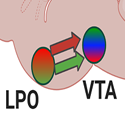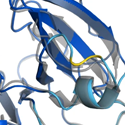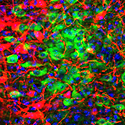Hot Off the Press – October 24, 2023 Published in Cell Reports by David Barker, Shiliang Zhang and Marisela Morales et al. from the NIDA IRP. Summary The ventral tegmental area (VTA) has been proposed to play a role in pain, but the brain structures modulating VTA activity in response to painful stimuli remain unclear…. [Read More]
News Main
Technology Development Initiative – Paper of the Month – October 2023
Sensitive multicolor indicators for monitoring norepinephrine in vivo. Nat Methods.
Existing GPCR-based Norepinephrine sensors are based on alpha-2a adrenergic receptors and do not exhibit the kinetic properties needed to investigate in vivo NE dynamics in response to different drugs. Kagiampaki et al. developed a new set of fluorescent indicators based on the alpha-1a adrenergic receptors. The nLight sensors combined with fiber photometry and two-photon imaging could be used to investigate spatial and temporal aspects of Norepinephrine signaling in animal models of substance use disorder. [Read More]
Lateral orbitofrontal cortex integrates predictive information across multiple cues to guide behavior
Hot Off the Press – October 2023 Published in Current Biology by Thorsten Kahnt, et al. Summary Predictive cues typically come in bunches and combining their predictions may improve behavior. Yet, we know almost nothing about how people process reward predictions from multiple cues as well as the brain mechanisms that are involved. Our manuscript… [Read More]
Comparative neuropharmacology of structurally distinct non-fentanyl opioids that are appearing on recreational drug markets worldwide
Featured Paper of the Month – October 2023
Published in Drug and Alcohol Dependence with contributions from Michael Baumann and colleagues from the NIDA IRP.
For this study, we examined the pharmacological effects of non-fentanyl synthetic opioids, including U-47700, brorphine, and isotonitazene, as compared to morphine and fentanyl.
Sarah Sarsfield Receives NIH Mission First! Safety Always Certificate of Appreciation
As the lab manager for the Aponte Lab, Sarah is one of the first people new lab personnel meet. She takes new lab members on a tour of the facility and points out emergency exits, eye washes, and fire alarms. Sarah reminds lab members how to properly store and dispose of all chemicals. Congratulations, Sarah… [Read More]
Brandon Harvey Receives NIH Mission First! Safety Always Certificate of Appreciation
Dr. Harvey is the chair of NIDA-IRP Safety committee and has initiated numerous safety initiatives in recent years including “NIDA Laboratory Clean Out Week”, coordinated with DEP to provide additional training on chemical waste handling in laboratories. Congratulations, Dr. Harvey and thank you for all of your hard work! The NIH Mission First Safety Always… [Read More]
High-precision mapping reveals the structure of odor coding in the human brain
Hot Off the Press – September 2023 Published in Nature Neuroscience by Thorsten Kahnt, et al. Summary Odorous molecules evoke distributed patterns of activity in olfactory cortices but how these patterns map onto inherently subjective odor percepts has remained unclear. In this study, Sagar and colleagues addressed this question by collecting high-resolution neural and perceptual… [Read More]
Technology Development Initiative – Paper of the Month – September 2023
Highly accurate protein structure prediction for the human proteome Nature.
Determining complete protein structures is difficult as sufficient quantities need to be purified; protein size, transmembrane domains, and susceptibility to conformational changes create inconsistencies; and the work can take months to years. Tunyasuvunakool et al. applied AlphaFold to predict full-length structures with detailed chemical components of nearly the entire human proteome (98.5%) as well as ~20 other organisms and provided this data in a public database. Since publication, the authors updated AlphaFold (version 2) shortening days-long prediction computation to minutes/hours and the database now has over 200 million protein structures. [Read More]
Inhibition of dorsal raphe GABAergic neurons blocks hyperalgesia during heroin withdrawal
Featured Paper of the Month – September 2023
Published in Neuropsychopharmacology by Yocasta Alvarez-Bagnarol, and Marisela Morales, et al. of the NIDA IRP Neuronal Networks Section.
We demonstrated that inhibition of Dorsal Raphe GABA neurons blocks hyperalgesia (increased pain sensitivity) induced by spontaneous heroin withdrawal.
PPARα and PPARγ are expressed in midbrain dopamine neurons and modulate dopamine- and cannabinoid-mediated behavior in mice
Hot Off the Press – August 28, 2023 Published in Molecular Psychiatry by Briana Hempel and Zheng-Xiong Xi, et al. of the NIDA IRP Addiction Biology Unit. In this research paper, Briana Hempel et al. investigated the role of peroxisome proliferator-activated receptors (PPARs) in the CNS effects of cannabinoids. The study focuses on two specific… [Read More]










